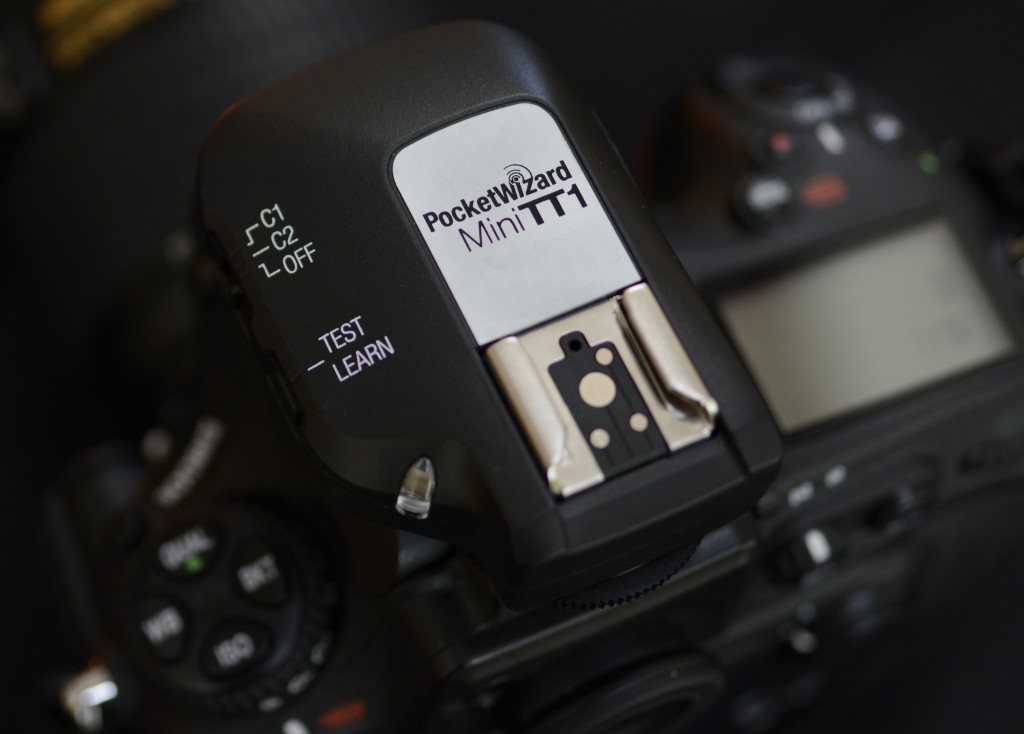 I still remember flashbulbs, flashcubes, and the early, all manual electronic flashes. Using these often resulted in the photographer’s question: did it trigger? And even if, the flashlight often made us look like white ghosts or dark shadows against the wall. At a given film speed and flash guide number (the maximum amount of light that the flash is able to burst off) the estimated flash-to-subject distance and the aperture were the only means of regulating the flash exposure.
I still remember flashbulbs, flashcubes, and the early, all manual electronic flashes. Using these often resulted in the photographer’s question: did it trigger? And even if, the flashlight often made us look like white ghosts or dark shadows against the wall. At a given film speed and flash guide number (the maximum amount of light that the flash is able to burst off) the estimated flash-to-subject distance and the aperture were the only means of regulating the flash exposure.
Why am I bringing this up? To name the strong and weak points of the transceiver system, it is fitting that I should briefly explain the techniques and acronyms of the modern system flashes.
It is well known that ambient-light exposure is regulated by shutter speed and aperture, shown in the first two installments of my series. But flash exposure is regulated by flash-to-subject distance and aperture only. The reason is that the shutter simply isn’t fast enough to control the incident light from the flash, which ranges from about 1/1000 to 1/40000 of a second. When the flash fires, the shutter must be completely open or there will be a shadow on the image. Nikon’s focal-plane shutters allow a top shutter speed of 1/250 to sync with the flash, while leaf shutters on medium format lenses usually go down to 1/800.

Left: Matrix meetering, no flash. Right: Manual exposure for the background (-2) stops, no flash.
For fill flash, a technique to flash away deep shadows in the subject, the only setting for balancing the two light sources is the aperture. The shutter speed must be changed to match up with the constant aperture to properly expose for the ambient light in the background. But this limits the creative freedom in terms of bokeh (out of focus rendering of the background) and light balance, because of the limited range of available shutter speeds: say between 1/60 to avoid motion blur in the ambient light “layer” and the 1/250 top sync speed for the flash. Fill flash does not freeze motion!
In the mid 1980s Nikon introduced real-time TTL (through-the-lens) flash technology to its film SLRs like the F3. The flash intensity is measured as the amount of reflected light from the film plane by metering cells placed inside the mirror box. With TTL technology, the camera’s computer provides the correct exposure, regardless of the aperture or flash-to-subject distance. The aperture can thus be selected for the desired depth-of-field and isn’t determined by the flash-to-subject distance. However, the camera’s light meters are still calibrated to 18% gray even in flash exposure. White or black subjects can mislead the metering and cause bad exposures. Moreover, exposure problems may result from the size of the subject and its placement in the frame.
When I turned digital two years ago, I bought a Nikon SB-910 Speedlight to go with the D800E. I was simply blown away by the simplicity of Intelligent TTL (i-TTL) and the Creative Lighting System (CLS). Since the reflection from the image sensor differs significantly from that of film, digital SLRs do not support real-time TTL flash metering but use a preflash metering. There can be up to a total of three groups of wireless remote flashes (to be triggered by the pop-up flash of from the SB-910 used as the master), which can be controlled independently with different exposure compensations directly from the (slightly hidden) camera menu.
Three light distribution patterns can be chosen to optimize light quality: Standard for general illumination, Center-weighted for portraits, and Even for groups and interiors. The Expanded Auto Power Zoom and the 3D metering systems smoothly cover lenses from 12 – 200 mm focal length. If the lens is focused on the subject, the flash will be controlled for proper exposure on the subject, leaving the background underexposed (and vice-versa).
The Balanced Fill Flash option (TTL-BL) yields a fine equilibrium between flash and ambient light, metered at the closest subject. This is shown in images 3 and 4 (matrix metering left and -2 stops exposure compensation on the right). It can be seen that in an overall darker image, the fill flash is reduced accordingly. I used this feature extensively (together with the shutter delay option) for balancing the lights in the Mingun caves (in my Myanmar portfolio) and in the ruins of Kolmanskop (Namibia).

Left: Matrix meetering and balanced fill flash (TTL-BL). Right: Matrix metering and -2 stops exposure compensation, balanced fill flash (TT-BL).
Focal Plane Flash (TTL-PF), a high-speed flash synchronization option, permits flash photography with a shutter speed faster than the camera sync speed of 1/250. The flash uses a sequence of pulsed flashes to circumvent the sync speed limitation and thus allows flash fill down to 1/8000. Being able to shoot portraits outdoors at any shutter speed is a huge advantage. The simplest way to “overpower” the sun in outdoor portrait shoots is therefore TTL-PF and aperture priority mode, not worrying about exposure time, and using the overall exposure compensation for the background and the flash exposure compensation for the subject.
However, focal plane flash is a very power-hungry technique because of the sequenced bursting (at a shutter speed of 1/1000 the guide number of the SB-910 will have dropped from 34 to 11, i.e., by a factor of eight). Keeping a short flash-to-subject working distance is therefore required. With a remote triggering system I could use my preferred 70-200 mm VR II lens for a high-sync portrait in midday sun and bring the flash close to the model. Moreover, off-camera flash positioning helps to avoid reflections from the object (seen in images 3 and 4) by mounting soft boxes that would otherwise obstruct the lens. In principle, this can be achieved with the pop-up flash of the D800E, but requires the flash be placed within the camera’s line-of-sight.
Impressed by the exuberant reviews, I opted for one of the more expensive solutions: The PocketWizard MiniTT1 (the camera top unit) and the FlexTT5 radio flash transceiver/receiver. In the brochure we read: … , the dedicated MiniTT1 Transmitter, with both CLS / i-TTL and Manual Power Control capability, is the perfect on-camera solution for any Nikon digital camera. As effortless as slide-in, turn-on and shoot.
Well, not quite. In addition to requiring a firmware update right out of the box and a well-respected turn-on sequence, the Flex/Mini solution supports neither Nikon’s i-TTL balanced, power zoom, 3D metering system, nor the mirror lock-up and shutter delay. In this sense we are back to the technology of the 1980s – the TTL without the “i”.
Obviously, the metering of the pre-flash is heavily biased towards the center and the active focus point is ignored. The result, out-of-camera, using the same settings as in image 4 is shown in image 5, with the figure overexposed by at least two stops. I should mention that the images are cropped, and therefore the subject occupies a rather small portion of the full frame. This is exactly the situation that confuses the camera’s metering system.

Left: Matrix meetering, off-camera flash (TTL-PF) triggered with Flex/Mini. -2 stops overall exposure compensation for the background. Right: Same setting but with -3 stops flash-exposure compensation.
At this point I should probably align my expectations: when the flash is off the hot-shoe, the camera can hardly know the flash-to-subject distance. The interesting aspect is, however, that the Nikon system does a much better job when the pop-up flash is used to trigger the remote flash. So there must be some communication between the remote flash and the camera that is not supported by the Flex/Mini. Using a -3 stop flash-exposure compensation results in image 6. Mounting a 21” softbox and increasing the flash-to-subject distance yields the desired light balance shown in the last image. It is of course a matter of taste, but in outdoor portraits I don’t like this overdone subject isolation that shouts: fill flash. To arrive at this result, it might have been faster to go fully manual and use an incident-flash lightmeter.
Fortunately, the support of the TTL-PF option, the main raison d’etre for the remote triggering system, has proven to work all right. So far, I experienced no triggering problems, the flash fires correctly in neighboring rooms of the house, and outdoors to at least 25 meters distance. Also the rear-curtain sync option is supported. I did not try the red-eye reduction mode, because I put this into the same category as the “smiling cat face” scene-mode on my wife’s point-and-shoot.

Matrix meetering, remote flash (TTL-PF), -3 stops flash-exposure compensation, -2 stops overall compensation for the background, 21″ soft box, shadow recovery in Photoshop.
So, will I keep the unit? Probably yes, because Nikon’s genuine trigger system uses infrared, which yields the same limitations as the pop-up flash. Is the PocketWizard Flex/Mini radio trigger as effortless as slide-in, turn-on and shoot? Definitely not.
4 Comments
Hi,
Great article. I just got the PW and noticed this issue. Nikon’s Master-remote IR works perfect (it’s TTL-BL), but with PW it seems to be just TTL… So images get over exposed just as you wrote… in this case it’s simpler to use manual flash instead of TTL…
Do you know any solution that will work just like Nikon’s master remote IR system? Is there anything available in the market? (The infra-red transmission is simply not good enough).
Thanks 🙂
No, I don’t know of any system that would support the TTL-BL. Infrared has of course the advantage that they can measure the subject to flash and camera distance because here everything must be kept in the line of sight. I don’t understand why they cannot use the pre-flash though. In the meantime I bought the SC-29 cord for portraiture and work around the limitations of the PocketWizard when need be.
Great article. You are right, the CLS iTTL system, with the flash as commander over infrared, is more sofisticated than the simple iTTL used when the flash is mounted on the hotshoe.
These radio triggers have all a misconcept: they pretend to substitute a iTTL cable with a radio transmission, forgetting that the iTTL cables are designed to having the flash in the hand of the photographer or mounted on a bracket, that means, the flash and the camera are at the same distance from the subject, so the lenses (D and G) provide the distance and the iTTL can properly work.
I have an SC-29. Here the description: “The Nikon SC-29 is an off-camera flash cord that provides full TTL control for Nikon Speedlites when used with Nikon SLR cameras which have the TTL hot flash shoe. 3′ long when coiled, it expands to 9′ and permits easy use of flash when the camera is mounted upon a bracket.”
When I was at an NPS presentation of the CLS system in Italy, I discovered that when the CLS system is activated and one SB or the on-camera flash is used as commander, the camera goes for an estimation of the distance of the remote flash to work in iTTL. The prefill flash commander is triggered and it can estimate the subject distance because of the autofocus + metering of the commander prefill flash. Then the prefill flash of the remote flash is triggered and metered TTL. As the prefill flash has always the same power, the camera can exitimate the distance of the flash from the subject and calculate the power needed to proper exposure the subject. The proper power per flash unit is communicated via the commander and triggered ….
So we must read between the lines. I already wondered why the flash cord is curled. It is not even supposed to be extended to the maximum of 9′ so that the flash-to-subject distance remains within reasonable limits for the “i” to function. But it would be long enough to allow mounting a softbox and therefore I should check this out.
And thanks for the clarification of the remote triggering through the pop-up-flash. It is exactly this kind of communication that I alluded to in the review.